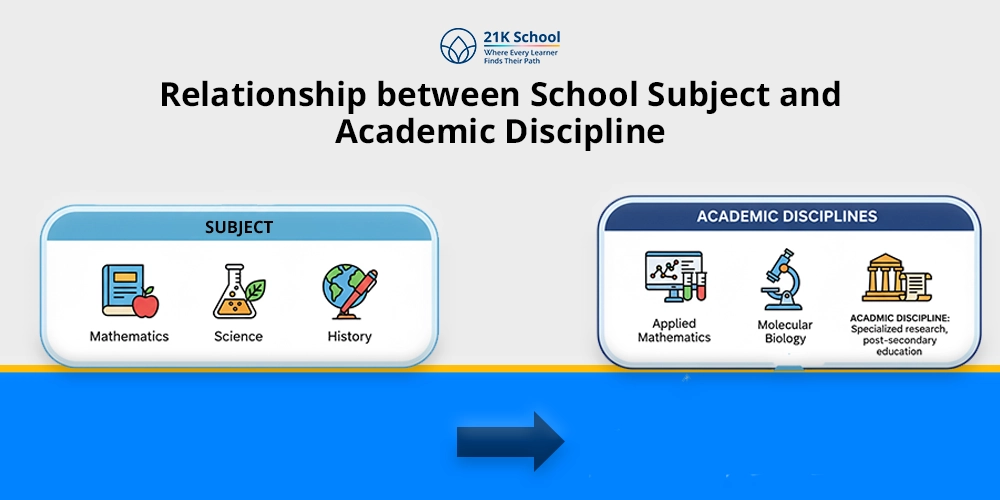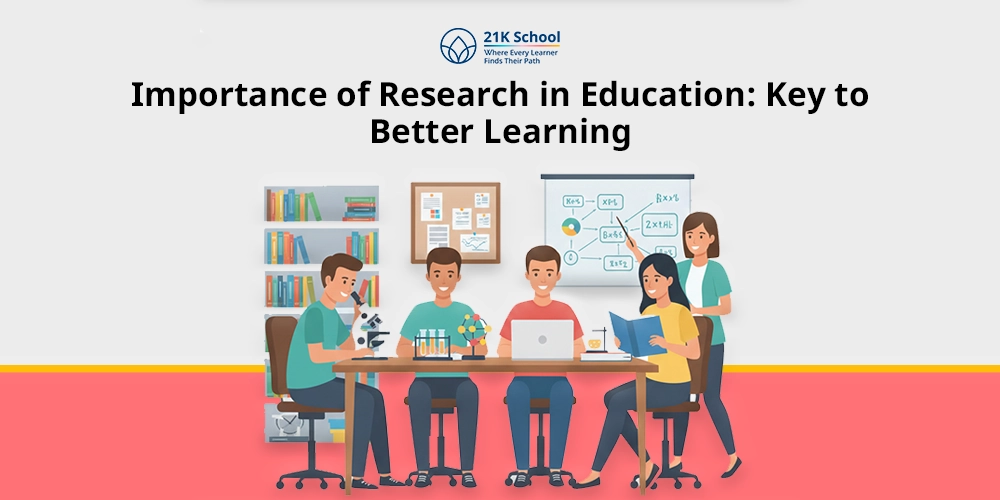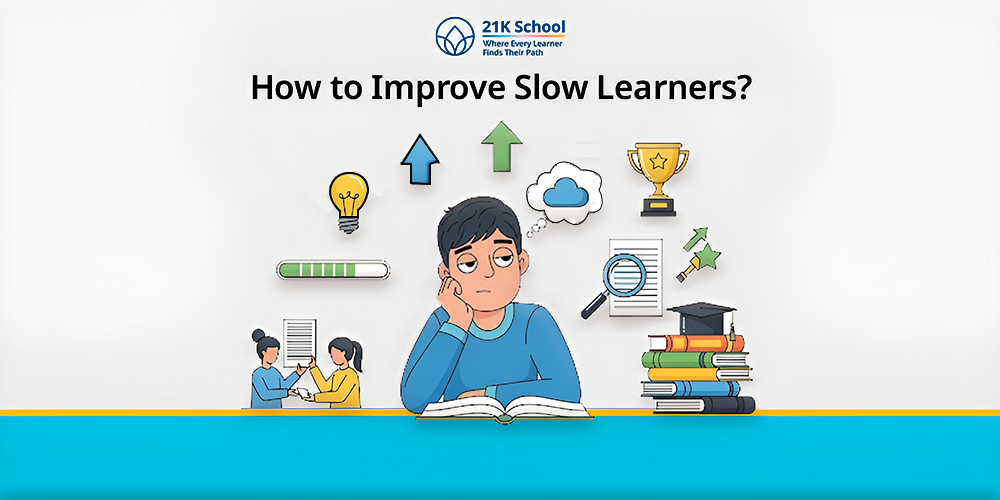
Do you know what is the best way to improve the learning outcome of slow learners?
Slow learners can be improved by implementing few action plans, techniques, aside incorporating activities which help in enhancing the learning outcomes of them.
Slow learners basically find it difficult to absorb any information at the same speed as their peers.
Slow learners are unable to perform better in their academics due to lower knowledge retention and inability to comprehend information.
Also, explore how to identify slow learners?
However, facilitators use various teaching methods to create a supportive environment specially in the classroom to help them.
Let’s get depth and understand the top ways to improve slow learners to enhance their personal and academic growth.
Table of Contents
- Top 18 Ways on How to Improve Slow Learners
- 1. Use Repetition Method
- 2. Use Digital Resources
- 3. Create an Inclusive Learning Environment
- 4. Positive Learning Environment
- 5. Indulge them in Group Activities
- 6. Allocate Extra Time
- 7. Provide them with Extra Guidance
- 8. Implement IEP
- 9. Incorporate Audio and Visual Aids
- 10. Peer Tutoring
- 11. Set Realistic Goals
- 12. Understanding Slow Learners
- 13. Customised Lessons
- 14. Differentiated Instruction
- 15. Set Smaller Targets for Slow Learners
- 16. Alternating between Teaching and Discussing
- 17. Be Supportive
- 18. Chunking and Scaffolding
- Additional Evidence-Based Techniques to Improve Slow Learners
- What is the Cause of Slow Learners?
- Conclusion
Top 18 Ways on How to Improve Slow Learners
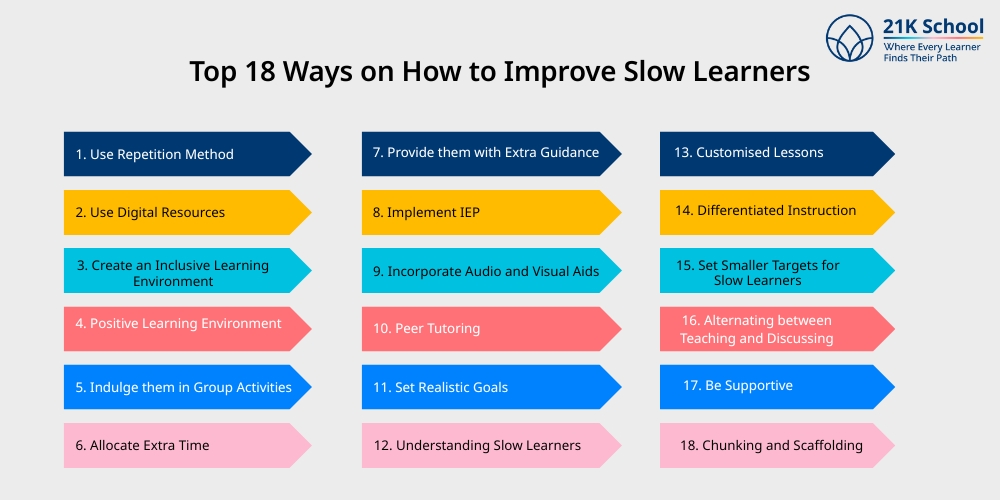
The learning outcomes of slow learners can be improved by implementing various strategies and programs that allow them to explore their limitations.
Here’s a detailed list of strategies to improve slow learners:
1. Use Repetition Method

Use of repetition method refers to facilitators repeating the same chapter or lesson to students for better understanding.
As slow learners feel challenged to compete with normal students, repetition is a better way of learning. Gaining the knowledge clearly improves children’s confidence and children’s mental health.
2. Use Digital Resources
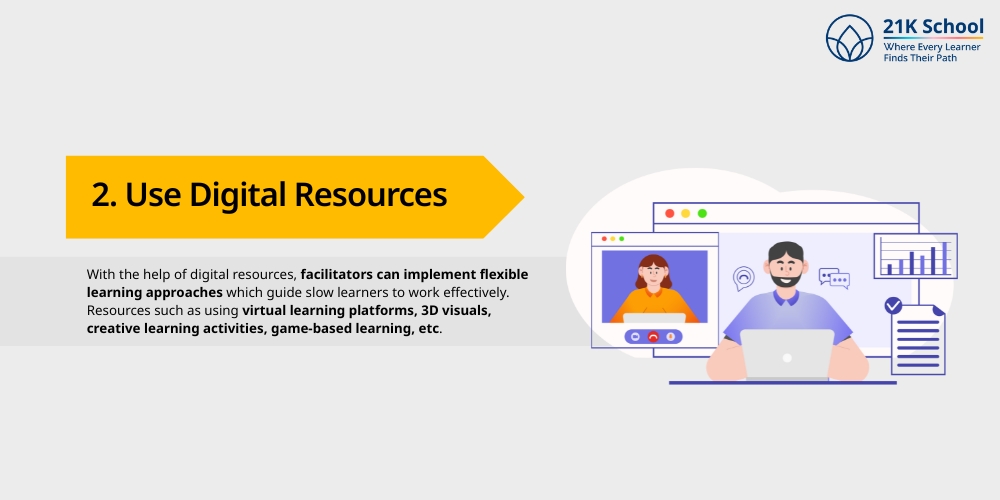
With the help of digital resources, facilitators can implement flexible learning approaches which guide slow learners to work effectively.
Resources such as using virtual learning platforms, 3D visuals, creative learning activities, game-based learning, etc.
By this way slow learners can work on their weaknesses without stressing out on rote learning.
3. Create an Inclusive Learning Environment
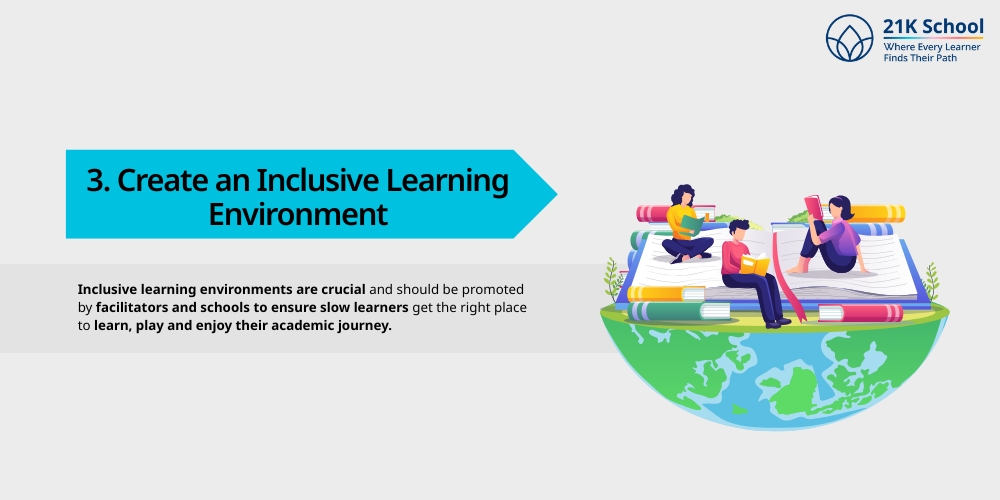
Inclusive learning environments are crucial and should be promoted by facilitators and schools to ensure slow learners get the right place to learn, play and enjoy their academic journey.
There are many benefits of inclusive education or inclusive classrooms which enhance learning to improve their skills and empathy.
4. Positive Learning Environment
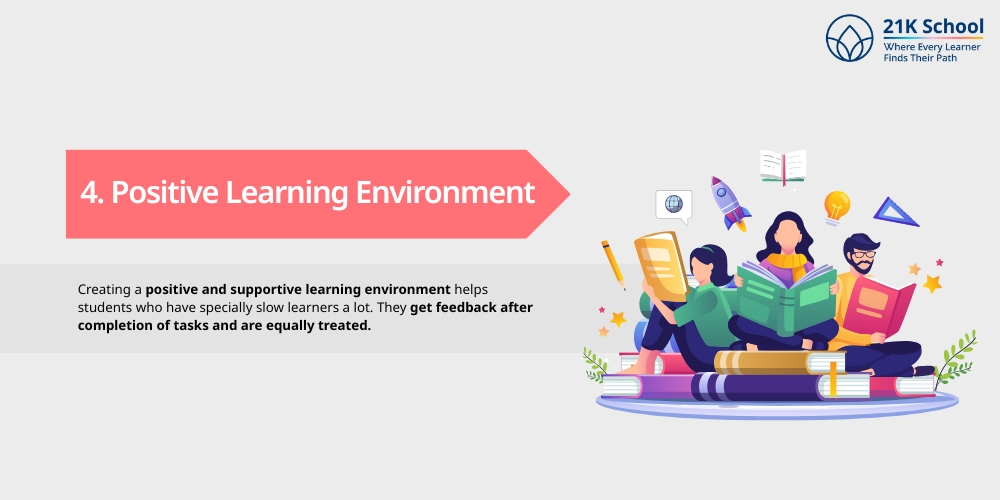
Creating a positive and supportive learning environment helps students who have specially slow learners a lot. They get feedback after completion of tasks and are equally treated.
Parents, school and facilitators responsibility to ensure a better place for learning and other activities.
5. Indulge them in Group Activities
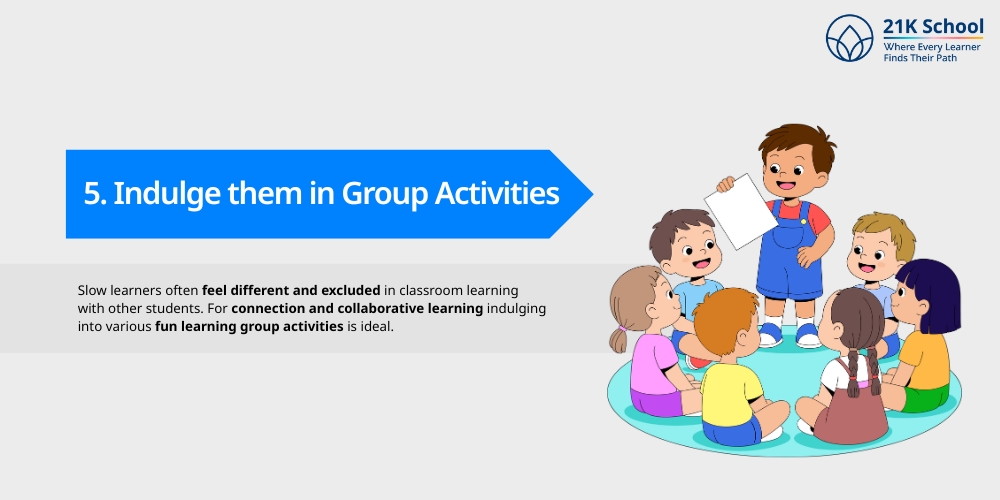
Slow learners often feel different and excluded in classroom learning with other students. For connection and collaborative learning indulging into various fun learning group activities is ideal.
Activities can be game based learning, gross motor skills activities, fine motor skill activities or science experiments for students.
It increases communication skills and collaboration skills in learners.
6. Allocate Extra Time

Teaching slow learners requires extra time to explain in depth and give the flexibility in learning new concepts. They take time to remember or retain facts or data as compared to peers.
Teachers should let them study at their own pace by creating a study time table as per their convenience.
7. Provide them with Extra Guidance
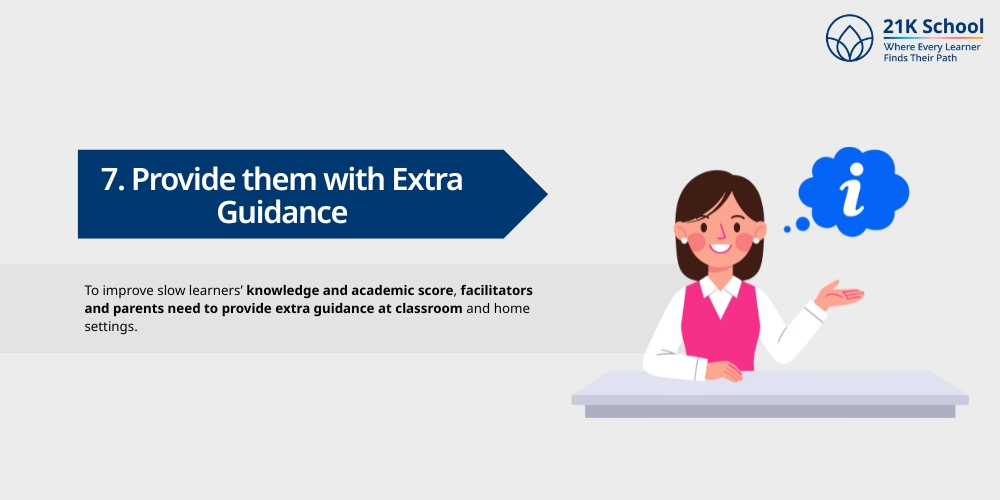
To improve slow learners’ knowledge and academic score, facilitators and parents need to provide extra guidance at classroom and home settings.
This can be done by monitoring their assignments, classwork giving feedback of improvement and providing various resources to work without any stress.
8. Implement IEP
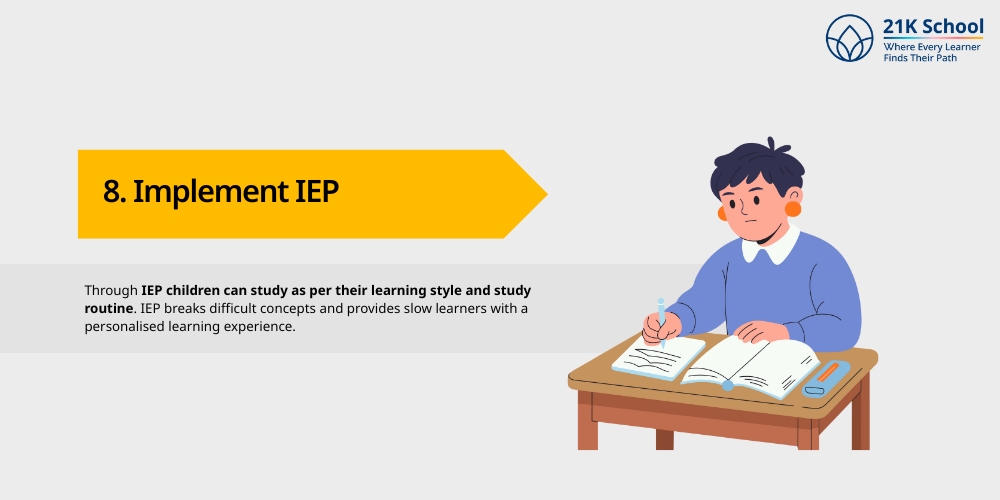
Individualised Education Plan is an ideal technique which mainly focuses on offering customised education to slow learners.
Through IEP children can study as per their learning style and study routine. IEP breaks difficult concepts and provides slow learners with a personalised learning experience.
9. Incorporate Audio and Visual Aids
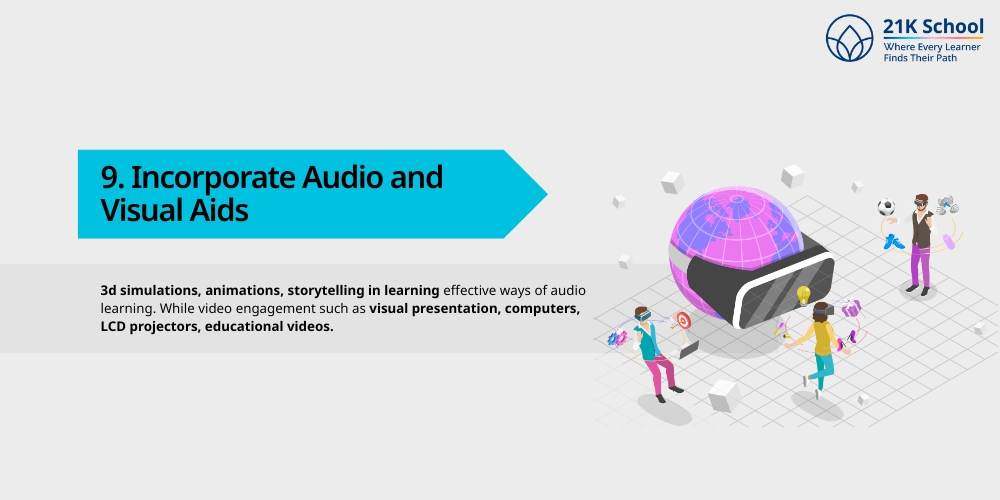
It is seen that repetition methods can make slow learners bored. Various engaging and interesting ways like incorporating audio and video aids in the classroom can be beneficial.
3d simulations, animations, storytelling in learning effective ways of audio learning. While video engagement such as visual presentation, computers, LCD projectors, educational videos.
10. Peer Tutoring
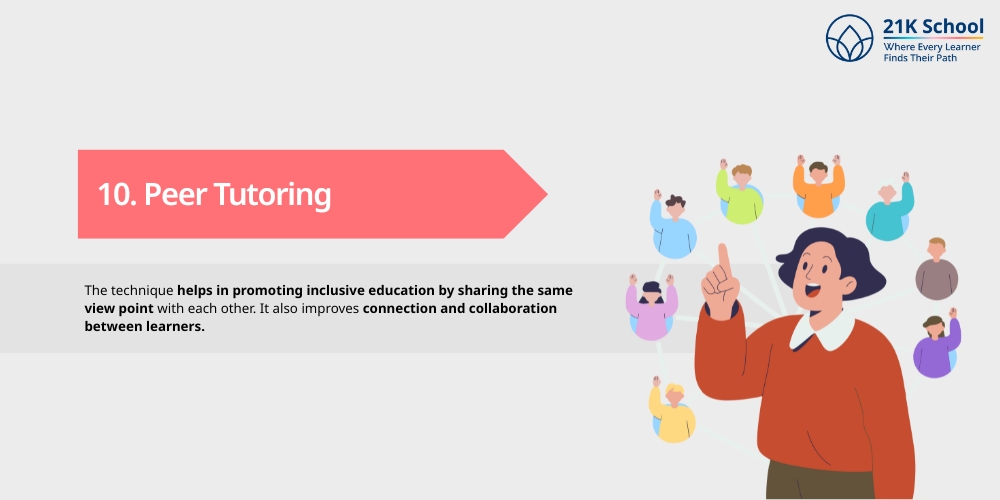
Peer to peer learning is one of the ideal ways through which classmates help each other to understand particular concepts in easier language.
The technique helps in promoting inclusive education by sharing the same view point with each other. It also improves connection and collaboration between learners.
11. Set Realistic Goals
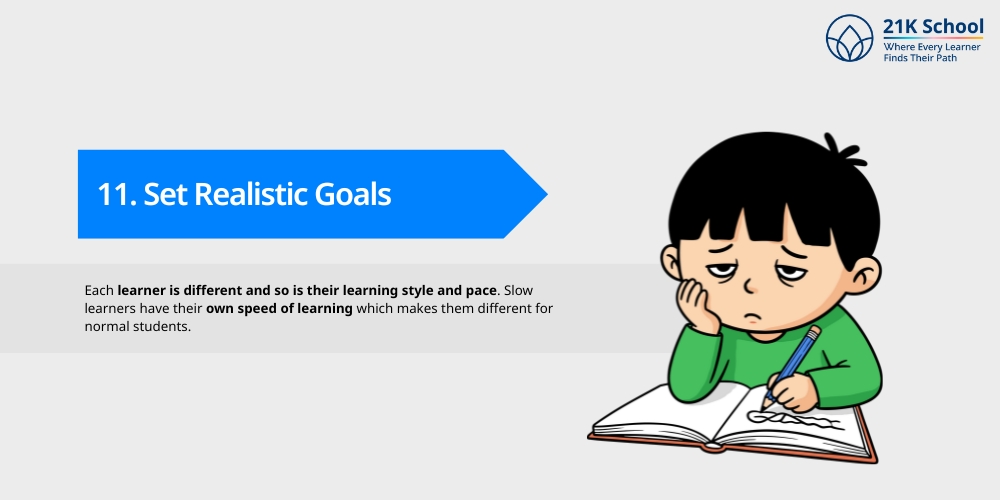
Each learner is different and so is their learning style and pace. Slow learners have their own speed of learning which makes them different for normal students.
That’s why setting a realistic goal is crucial instead of comparing or giving them the same assignments as other students.
12. Understanding Slow Learners
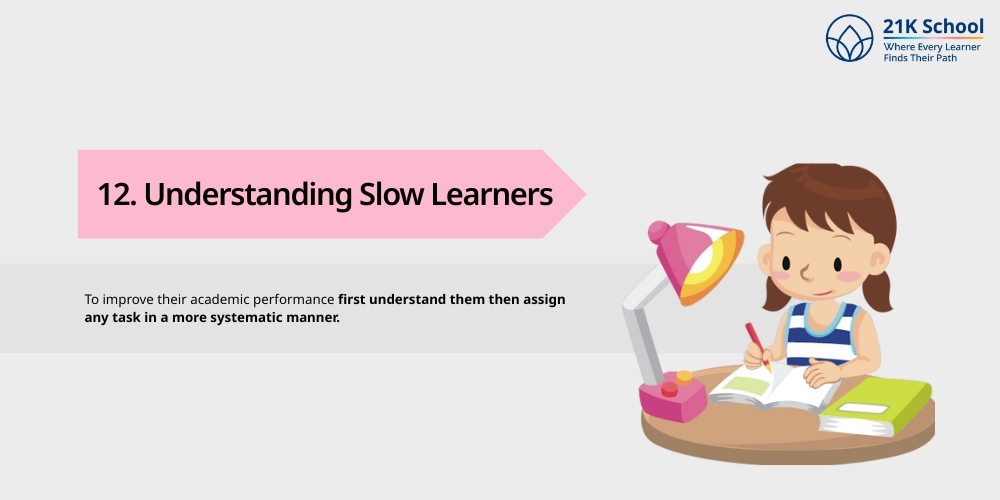
Slow learners have their own learning method and speed which makes them different from other students.
To improve their academic performance first understand them then assign any task in a more systematic manner.
13. Customised Lessons

Facilitators need to carefully address slow learners how they are working and offer customised syllabus, lessons and curriculum for future progress.
Also provide both when sure they are not struggling with one topic.
14. Differentiated Instruction
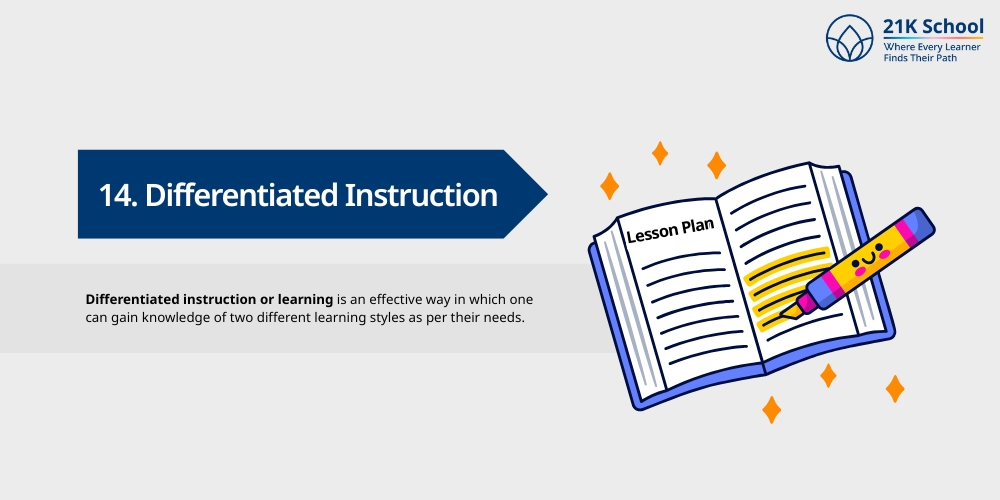
Differentiated instruction or learning is an effective way in which one can gain knowledge of two different learning styles as per their needs.
Differentiated instruction allows slow learners to develop their learning potential by focusing on modified assignments and classwork.
15. Set Smaller Targets for Slow Learners
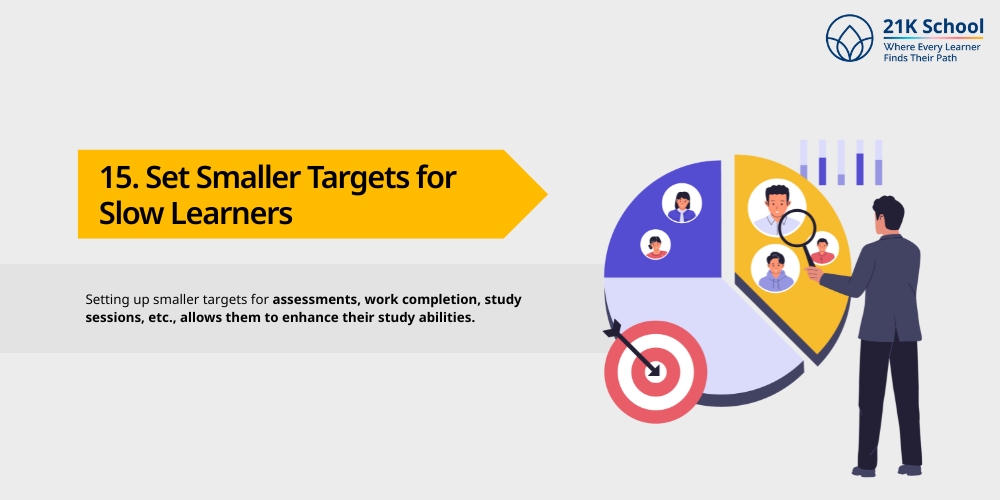
While setting-up study targets it is essential for students to set smaller targets. As slow learners have difficulties in studying quickly due to which they find it difficult to memorise things quickly.
Setting up smaller targets for assessments, work completion, study sessions, etc., allows them to enhance their study abilities.
16. Alternating between Teaching and Discussing
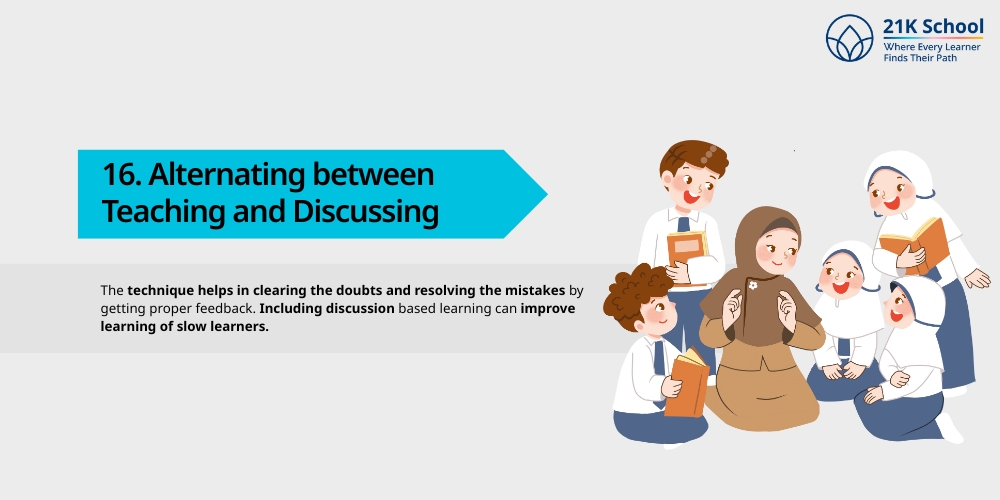
Education is not limited to teaching and listening to understand concepts. It also includes discussion between teacher and students or peer to peer.
The technique helps in clearing the doubts and resolving the mistakes by getting proper feedback. Including discussion based learning can improve learning of slow learners.
17. Be Supportive
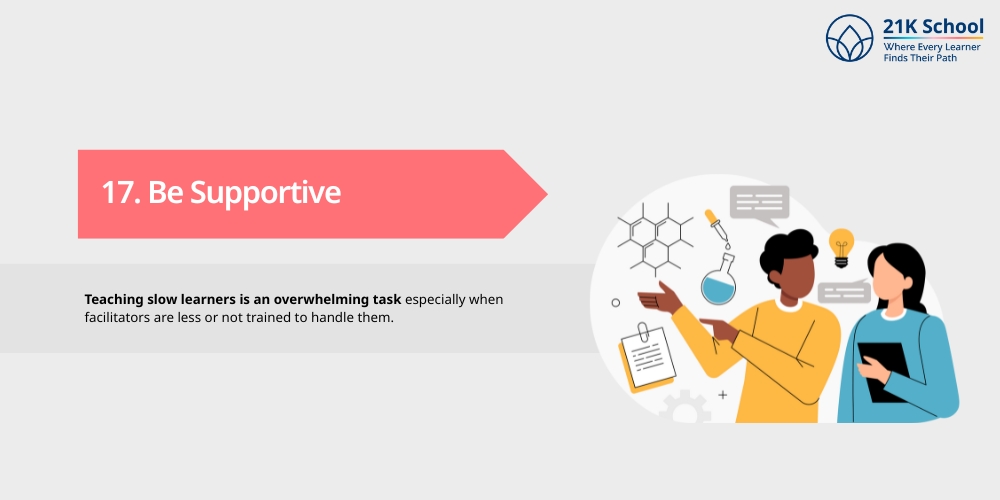
Teaching slow learners is an overwhelming task especially when facilitators are less or not trained to handle them.
However, becoming supportive can reduce the challenges. Make sure the environment is positive and encourage them to actively participate in discussions, tests and fun learning activities.
18. Chunking and Scaffolding
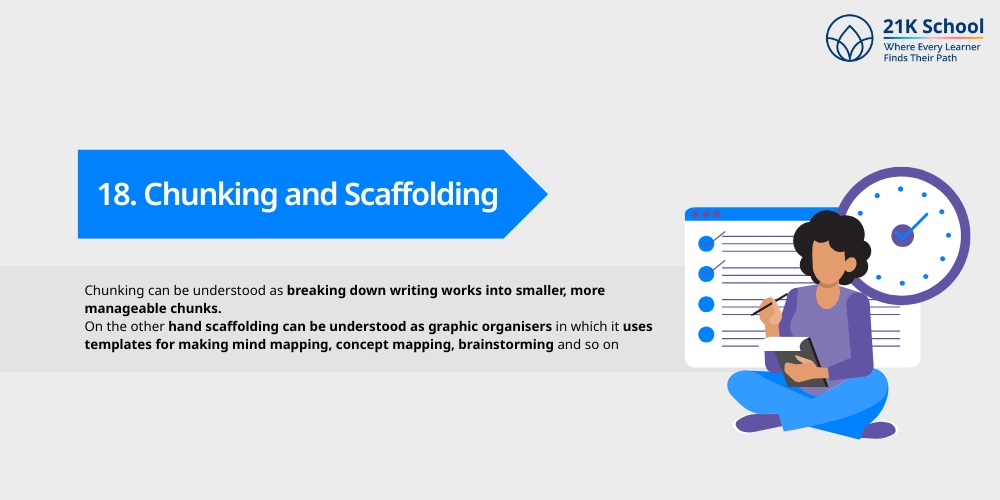
Chunking can be understood as breaking down writing works into smaller, more manageable chunks.
On the other hand scaffolding can be understood as graphic organisers in which it uses templates for making mind mapping, concept mapping, brainstorming and so on.
This technique is known for enhancing the cognitive development of children, making education impactful for slow learners.
Additional Evidence-Based Techniques to Improve Slow Learners
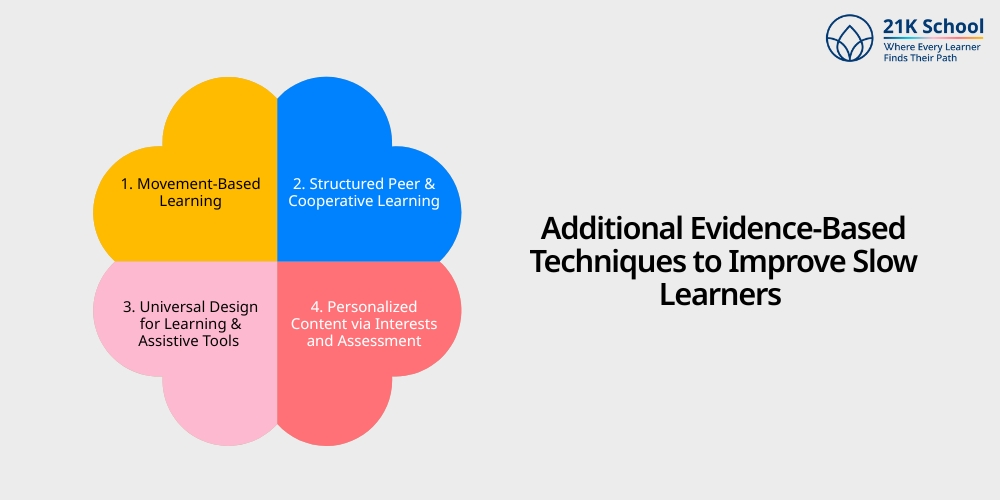
Evidence-based techniques are various teaching methods used after scientific research, evaluation instead of traditional approaches.
For slow learners key strategies includes:
1. Movement-Based Learning
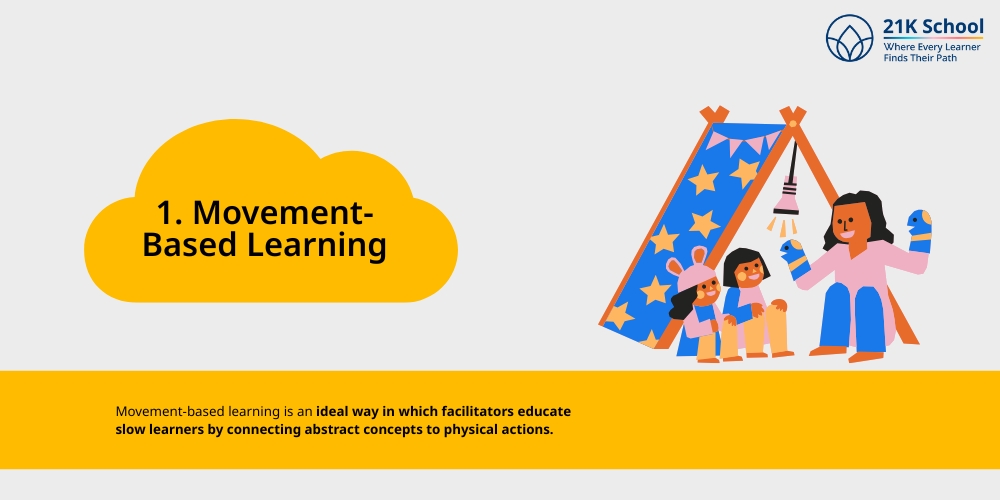
Movement-based learning is an ideal way in which facilitators educate slow learners by connecting abstract concepts to physical actions.
Some common examples of evidence based movement technique include storytelling with movement, short breaks for stretching or quick dance, and interaction with peers.
2. Structured Peer & Cooperative Learning

With structured peer and cooperative learning, slow learners get a chance to achieve academic success with effective networking.
The approach is ideal for a meaningful and inclusive learning experience for all students.
3. Universal Design for Learning & Assistive Tools
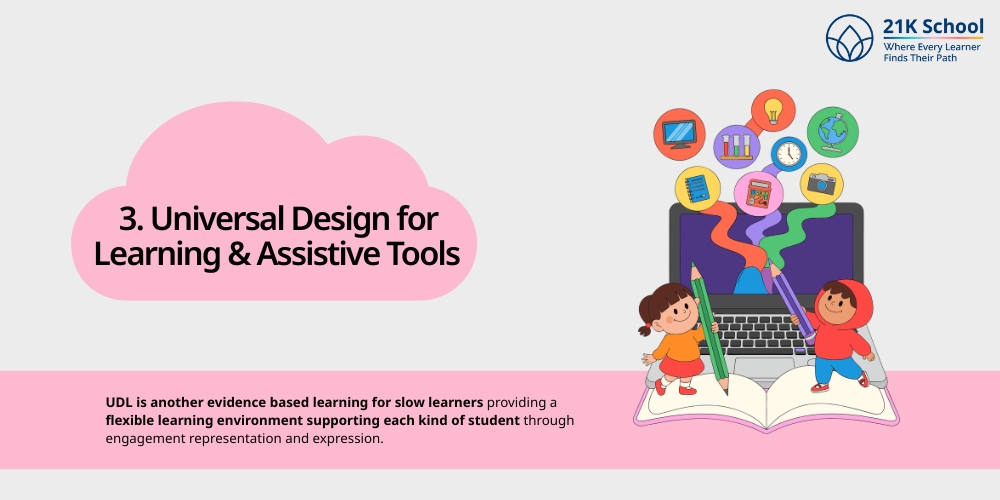
UDL is another evidence based learning for slow learners providing a flexible learning environment supporting each kind of student through engagement representation and expression.
UDL encourages inclusion, reduces barriers and provides tools and techniques to monitor progress.
4. Personalized Content via Interests and Assessment
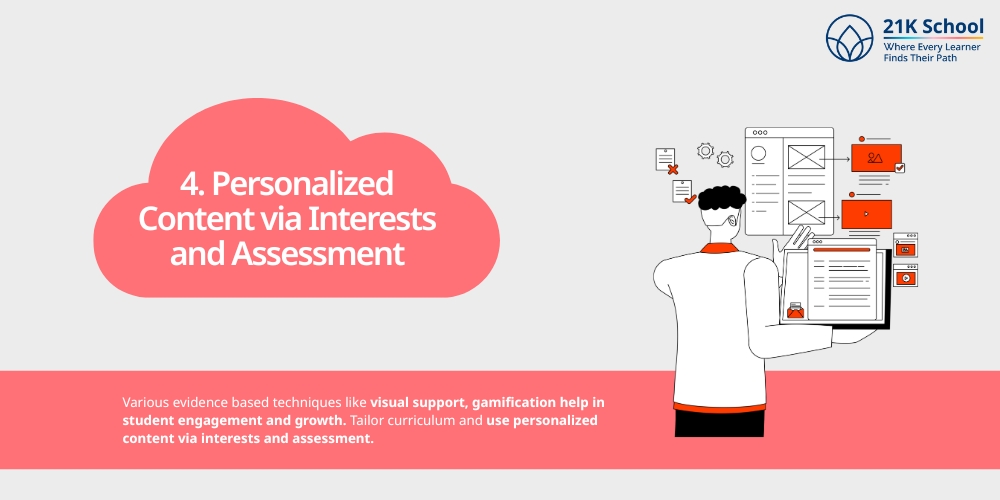
Personalised learning is helpful in identifying kids’ learning style and speed.
Various evidence based techniques like visual support, gamification help in student engagement and growth. Tailor curriculum and use personalized content via interests and assessment.
What is the Cause of Slow Learners?
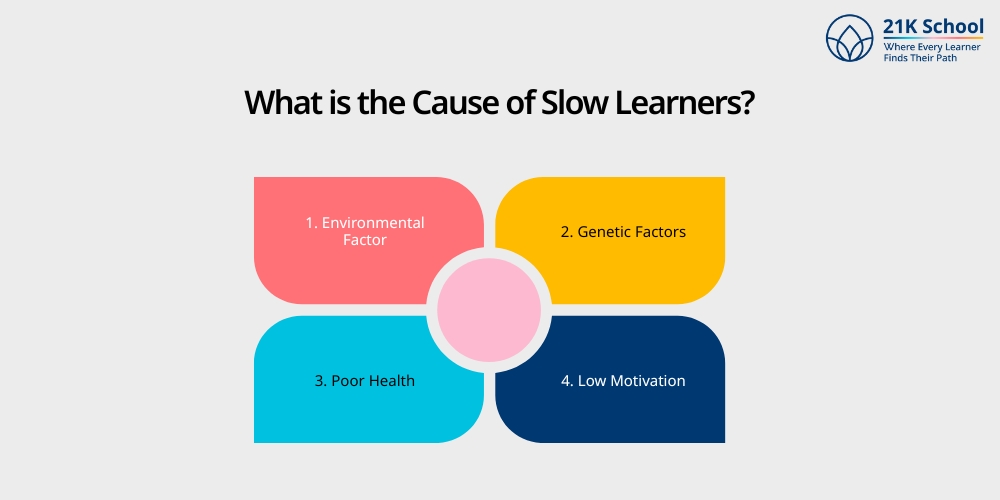
Slow learners are basically considered as slow due to which they are unable to think from different perspectives. Slow learners become slow due to various reasons such as cognitive factors, genetic factors, health issues, lack of motivation and so on.
Due to this slow learners find it difficult to comprehend any information or hampers their creative thinking skills. Here you can check the main reason for slow learners.
1. Environmental Factor
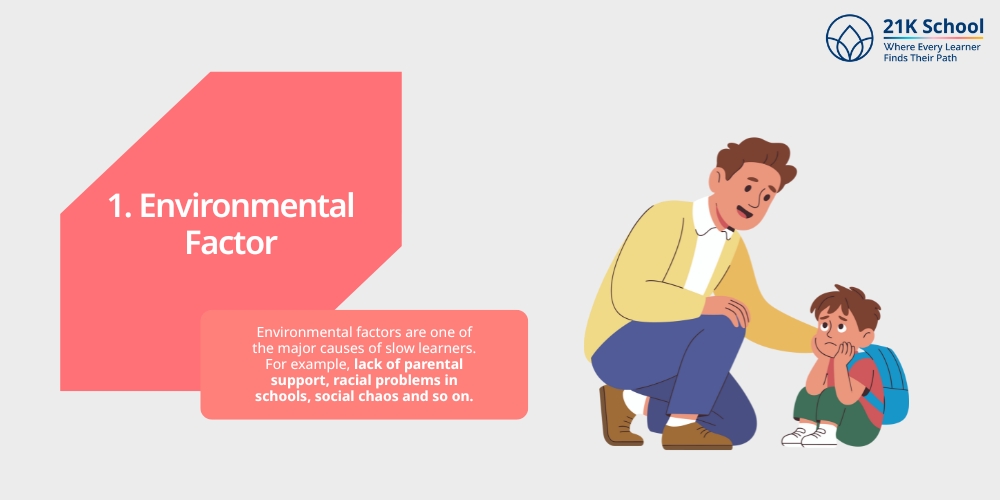
Environmental factors are one of the major causes of slow learners. For example, lack of parental support, racial problems in schools, social chaos and so on.
These factors affect the mental ability of children due to which they are unable to think more precisely.
2. Genetic Factors

Genetic factors also play a major role or cause of slow learners. Due to this genetics children become slow learners or carry some genes or conditions.
Genetic factors may also include syndromes and disabilities. This hampers the learning process of such children.
3. Poor Health

Poor health of children is another major factor for making children slow learners. Various health related issues hamper children’s ability to retain information and resources.
Improper health conditions also hamper children’s learning ability, resulting in making slow learners.
4. Low Motivation
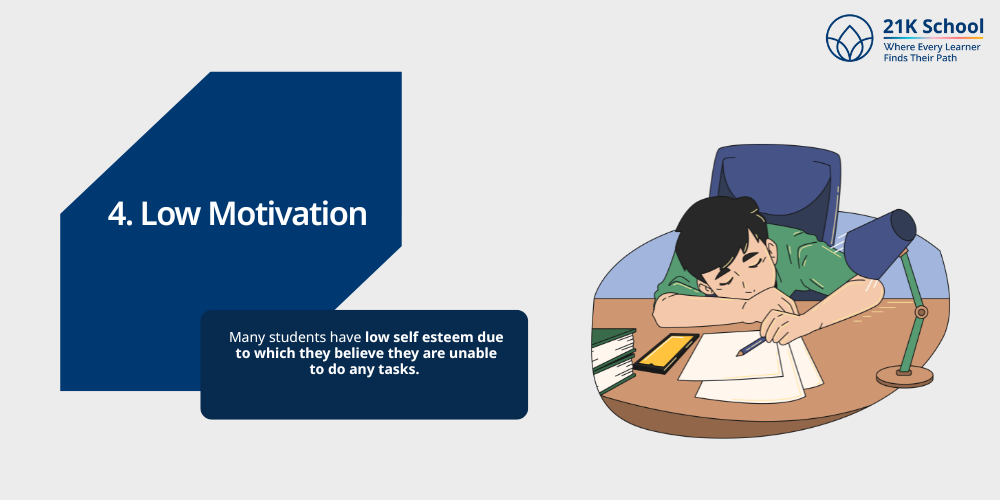
Low motivation towards education is the major cause that hampers the ability of students to learn more freely. Many students have low self esteem due to which they believe they are unable to do any tasks.
This negatively impacts their concentration and ability to comprehend any information. This causes them to become slow learners.
Conclusion
Learning above mentioned 18 ways to improve slow learners are effective, proven and ready to implement for slow learners progress.
For better implementation go through remedial teaching action plan for slow learners to achieve desired goals.
If you are a parent or facilitator it’s crucial to support both the academic and personal needs of learners in the classroom and at home to make them strong and confident.
Various strategies such as group projects and online learning resources can be ideal to increase the curiosity and interest towards modern learning. To know more visit our official website 21K School today!

